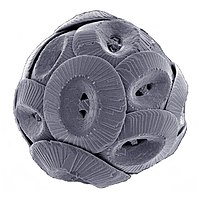
Photo from wikipedia
BackgroundMarine bivalves undergo complex development processes, such as shell morphology conversion and changes of anatomy and life habits. In this study, the transcriptomes of pearl oyster Pinctada fucata martensii and… Click to show full abstract
BackgroundMarine bivalves undergo complex development processes, such as shell morphology conversion and changes of anatomy and life habits. In this study, the transcriptomes of pearl oyster Pinctada fucata martensii and Pacific oyster Crassostrea gigas at different development stages were analyzed to determine the key molecular events related to shell formation, settlement and metamorphosis.ResultAccording to the shell matrix proteome, biomineralization-related genes exhibited a consensus expression model with the critical stages of shell formation. Differential expression analysis of P. f. martensii, revealed the negative regulation and feedback of extracellular matrixs as well as growth factor pathways involved in shell formation of larvae, similar to that in C. gigas. Furthermore, neuroendocrine pathways in hormone receptors, neurotransmitters and neuropeptide receptors were involved in shell formation, settlement and metamorphosis.ConclusionOur research demonstrated the main clusters of regulation elements related to shell formation, settlement and metamorphosis. The regulation of shell formation and metamorphosis could be coupled forming the neuroendocrine-biomineralization crosstalk in metamorphosis. These findings could provide new insights into the regulation in bivalve development.
Journal Title: BMC Genomics
Year Published: 2019
Link to full text (if available)
Share on Social Media: Sign Up to like & get
recommendations!